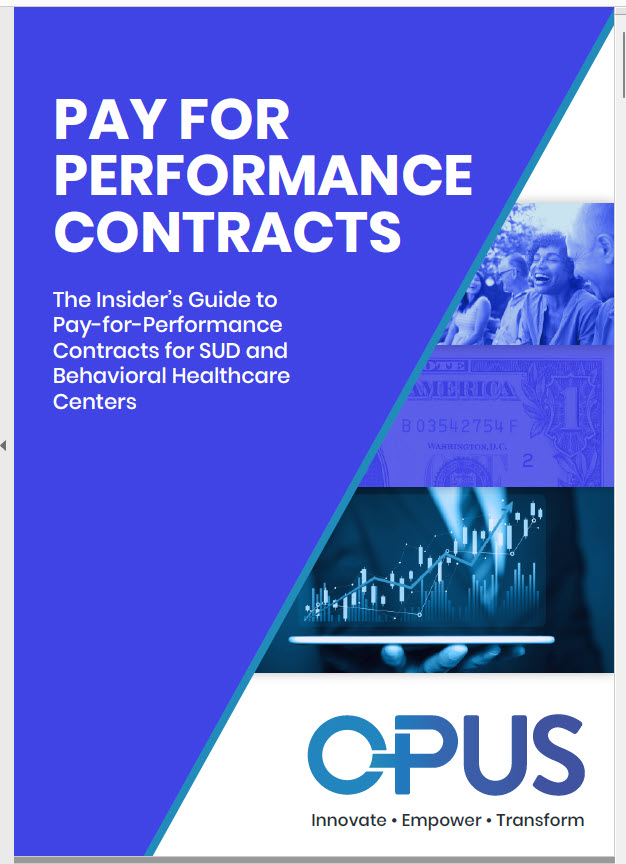6 KPIs for Behavioral Health - Why Pay for Performance Matters for Reimbursement
Behavioral health facilities and substance abuse centers have always faced the financial challenges of increasing their revenues while promoting positive patient clinical outcomes.
The pandemic has compounded this challenge. Facility closings, lack of staff, increased cost-of-living expenses and supply shortages have impacted the bottom line.
But what if you could increase revenue and promote patient satisfaction by considering a Pay-for-Performance (P4P) model of reimbursement instead of the traditional Fee-for-Service standard of payment.
A successful transition from one model to another is often based on your ability to generate the right reports and share measurable performance milestones, aka. key performance indicators (KPI) with the payor.
Is Pay-for-Performance in Your Best Interest?
Prepare to Prosper with a Value-Based Payment Model at your Behavioral Health Treatment Center.

6 Most Common KPIs and Reports Used by Behavioral Health Facilities
As leading providers of EHR platforms for behavioral health facilities and substance abuse centers, here are the 6 most common KPIs and reports used:
- Average Length of Stay: Relevant only to inpatient facilities, this statistic is computed by dividing the number of days the patient stayed in a facility by the number of admissions or discharges.
- Follow-up care (7/30 days): Follow up care is an important Healthcare Effectiveness Data Information Set (HEDIS) measure for payors. But unless you provide both outpatient and higher levels of care, this measure is difficult to track on your own. Facilities providing higher levels of care have reported that working closely with out-patient groups to treat their patients for after-care has been beneficial and ultimately reduces readmission and emergency room visits. Post discharge patients should receive a 7 and 30 day follow up outpatient visit with a therapist.
- Patient Satisfaction Score: Another key measurement tracked by the payor is the Patient Satisfaction Score which demonstrates the clinician’s interest in the quality of care and monitoring general patient improvement.
Here are some effective parameters we ask patients to rate, based on feedback from all our client facilities and centers:
Rate the following on a scale of 1-5 (with 5 being the highest):
- Intake process
- Orientation experience
- Individual and group sessions
- Clinical program
- Staff (therapists, case managers, nursing staff, physicians, behavioral health technicians, recovery coaches etc.)
- Dining services
- Facility cleanliness
- Overall experience
Download an Example of a Patient Satisfaction Scorecard Here.
This questionnaire captures self-reported assessments of the patient experience. The survey allows the provider to analyze the data, reach out to patients who had a less than stellar experience and reassess the treatment process. It also allows the center to collect feedback on what’s working well and what is not working so well.
Typically, there are three areas to apply the feedback and/or make improvements, including: (1) A Product/Service (new/existing), (2) Process (new/existing), or (3) People (coaching, training, hiring for a new role).
- Net Promoter Score (NPS) report: The Net Promoter Score (NPS) is a survey used to measure client loyalty and how likely your patients are to refer your services to others. A high score can translate into higher referral and pay-for-performance reimbursement rates.
Based on an index ranging from -100 to 100, the NPS is measured through ONE question: On a scale of 1 to 10, how likely are you to recommend our [CENTER/FACILITY] to others?
When it comes to NPS, the higher the better. An excellent score is between 70 and 100. Between 30 and 70 is a great score, while 0 to 30 is a good score.
If your NPS is below zero, it can be an indicator your organization is having a hard time meeting patients’ expectations.
- Evidence-Based Patient Outcome Measurement Tools: Evidence has shown that use of patient outcome measurement tools and rating scales will improve clinical results for mental health and substance use treatment. Completed directly by patients, these reports are designed specifically to capture self-reported versus provider-reported symptoms or severity of depression, anxiety, trauma, disorganized thinking, and problems with daily functioning.
Not only does evidence-based patient measurement care lead to improved clinical care for the individual patient, it also provides the foundation for measurement of quality, which impacts payor reimbursement and patient satisfaction.
Your EHR platform can facilitate collecting the following data for your payor:
- PHQ-9: Measures a patient’s progress toward achieving depression remission
- GAD-7: Screens the severity measuring of generalized anxiety disorder
- PCL: Provides a 20-item self-report checklist for screening PTSD symptoms
- PRIME: Assesses individuals at risk for developing a psychotic disorder
- WHODAS 2.0: Evaluates 36-items for assessing disability in terms of functioning
- Utilization Review Report: This report evaluates the healthcare services provided to make sure they were necessary, appropriate, and efficiently performed. Specific EHR systems let you custom build reports to submit to your payor (like your Average Length of Stay), improve outcomes with customized workflows and actionable insights at a glance, and ultimately improve reimbursements.
Insurance companies want to maximize efficiency and minimize payouts while clinical centers try to optimize the treatment to maximize results.
That’s why it is important to put a process in place to align your internal contract and utilization review teams and work closely together to achieve your patient and financial outcomes. This can be accomplished by setting up a formal schedule to exchange information, communicate goals and review expectations. A shared data base can facilitate the process of storing and exchanging information and a collaborative effort will help ensure you are meeting patient and contract expectations.
At Opus, we have seen firsthand the benefits of Pay-per-Performance contracts and the steps that have effectively helped our clients negotiate a P4P contract with insurance companies.
Our EHR system can custom build reports for you to submit to your payor (like your Average Length of Stay), improve outcomes with customized workflows and actionable insights at a glance, and ultimately improve reimbursements.
To learn more how generating the right reports and sharing KPIs with the payor, can increase your reimbursement, download our Insider’s Guide to Pay-for Performance Contracts for SUD and Behavioral Healthcare Centers.






